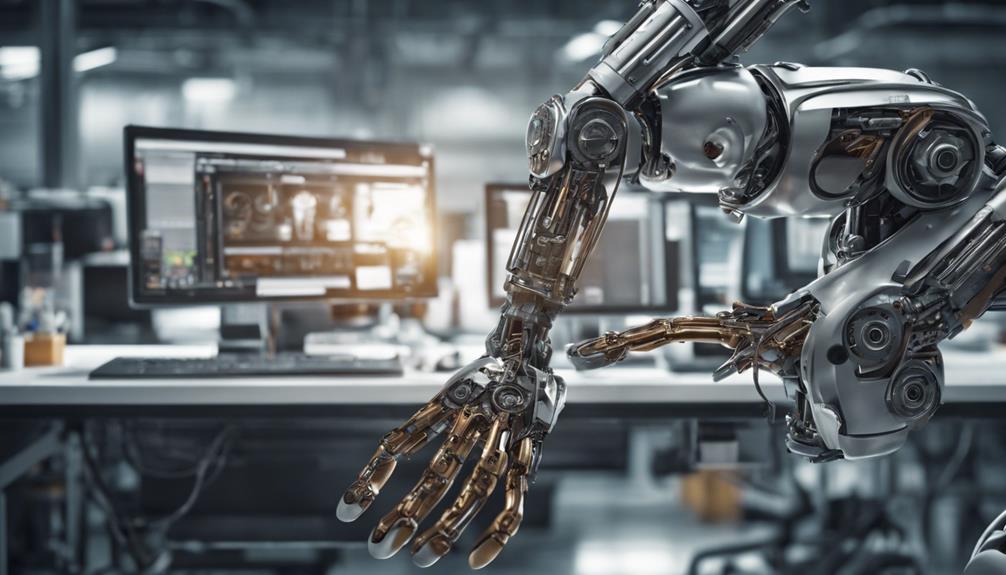In a society where technological advancements are reshaping the traditional job market, it is crucial to understand the increasing role of robots in replacing human workers. The concept of job security is being questioned, causing individuals to reassess their career paths and skills.
As robots infiltrate industries at an accelerating pace, the question arises: How can one navigate this shift to not only survive but thrive in the face of automation?
This guide offers a strategic approach to address the impact of robots on job security and provides insights into essential strategies for adapting to this new era of work.
Key Takeaways
- Proactively invest in skills less susceptible to automation to secure job stability.
- Transition to roles emphasizing high human interaction to remain valuable in the workforce.
- Stay updated on industry trends and technology advancements for competitive advantage.
- Upskill and reskill through targeted training programs to adapt to automation changes.
Impact of Robots on Job Market
The introduction of artificial intelligence (AI) into various industries is significantly reshaping the job market dynamics, with projections indicating the replacement of 85 million jobs globally by 2025. This AI impact is causing concerns about job displacement and potential robot takeover, leading to disruptions in traditional job roles.
While fears of robots replacing human workers may be exaggerated, there is a valid concern regarding job loss and automation in certain sectors. Research suggests that specific job roles such as customer service representatives, car and truck drivers, computer programmers, research analysts, and paralegals are at higher risk of being supplanted by AI technologies.
Despite this, it is essential to note that AI advancements also create opportunities for the creation of new jobs in emerging fields. The job market disruption caused by automation requires a strategic approach to reskilling and upskilling the workforce to adapt to the evolving demands of the industry.
Jobs Vulnerable to Automation

With the accelerated advancement of technology, certain job sectors face a heightened risk of automation displacing roles traditionally held by human workers. Jobs vulnerable to automation include customer service representatives, car and truck drivers, computer programmers, research analysts, and paralegals. These roles are at risk due to the increasing capabilities of robots, AI, and technology to perform tasks that were once exclusive to human workers. Industries such as healthcare, agriculture, and manufacturing are experiencing significant job displacement as automation continues to advance.
| Jobs | Reasons for Vulnerability | Industries Affected |
|---|---|---|
| Customer Service Reps | Repetitive tasks, chatbots, AI integration | Various |
| Car and Truck Drivers | Autonomous vehicles, delivery drones | Transportation |
| Computer Programmers | Code automation tools, AI programming | IT |
| Research Analysts | Data analysis algorithms, AI research | Research & Analysis |
As technology progresses, new roles will emerge, and workers will need to adapt to these changes to remain valuable in the evolving job market.
Strategies for Job Security
In navigating the evolving landscape of job automation, strategic planning and proactive skill development are crucial for ensuring long-term job security. To safeguard against the encroachment of automation, individuals should invest in acquiring skills that are less susceptible to robots taking over, such as critical thinking, creativity, and complex problem-solving abilities. Additionally, considering transitioning to roles that require high levels of human interaction or emotional intelligence can enhance job security in the face of automation threats.
Staying abreast of industry trends and technological advancements is paramount in adapting to the changing job market and positioning oneself for emerging job opportunities. Embracing opportunities for upskilling or reskilling through online courses, workshops, or vocational training programs is essential for remaining competitive in an increasingly automated world.
Networking with professionals, attending industry conferences, and seeking mentorship are valuable strategies for gaining insights into how industries are evolving and how to secure one's job against automation. By actively engaging in skills acquisition and staying informed about industry developments, individuals can fortify their job security in the era of automation.
Adapting to Automation Changes

Amid the rapid advancements in automation technology, adapting to these changes necessitates a proactive approach towards acquiring new technical skills and training in robot operation and construction. Embracing automation transformations requires individuals to enhance their expertise continuously. Here are key steps to adapt effectively:
- Invest in Technical Skills: Developing proficiency in robot operation and construction is essential to remain competitive in the evolving job market.
- Explore Training Opportunities: Engaging in targeted training programs can provide hands-on experience and knowledge crucial for mastering automation-related tasks.
- Addressing Skilled Workers Shortage: The industry's demand for skilled workers in automation is high, underscoring the urgency for individuals to upskill and meet the workforce needs.
Thriving in Automated Workplaces
Navigating the landscape of automated workplaces requires a strategic blend of technological proficiency and adaptability to ensure sustained success in an evolving job market. With automation driven by efficiency, robots are increasingly handling tasks like cleaning, painting, and customer service. Companies deploying robots aim to free up human workers for more complex roles, striking a balance that enhances productivity and efficiency.
The pandemic has accelerated automation adoption, making it a common feature in various industries. Ensuring job opportunities for workers while integrating AI systems is vital. Training in robot operation and construction is now in high demand to meet the evolving workforce needs. Thriving in automated workplaces necessitates a collaborative approach between robots and the human workforce, leveraging technology to optimize efficiency without compromising job prospects.
Frequently Asked Questions
Are Robots Going to Take Over Jobs?
Robots are not slated to entirely take over jobs. Although automation and AI may replace some roles, tasks requiring complexity and human interaction are more secure. Human-robot collaboration is enhancing labor value across industries.
At What Rate Are Robots Taking Over Jobs?
Robots are replacing jobs at a rate lower than perceived; only 14% of workers report job displacement by robots. There is a significant disparity between perception and reality, with estimates from displaced workers suggesting 47% of jobs replaced.
How AI Is Replacing Jobs?
AI is replacing jobs through automation in industries like healthcare, agriculture, and technology. Roles like customer service representatives, drivers, programmers, research analysts, and paralegals are at risk. AI technologies like chatbots, autonomous vehicles, and coding tools are contributing to this trend.
How Are Robots Changing the Workplace?
Robots are revolutionizing the workplace by enhancing efficiency, reducing costs, and streamlining processes across industries. This shift towards automation necessitates a workforce with advanced technological skills to adapt to the changing demands of modern businesses.
Conclusion
In conclusion, the increasing presence of robots in the workforce is transforming the job market, with certain professions facing higher risks of automation than others.
One interesting statistic to consider is that by 2030, it is projected that up to 800 million global workers could be displaced by automation.
It is essential for individuals to adapt to these changes, explore new job opportunities, and understand the evolving role of human workers in the age of AI and robotics.









